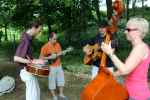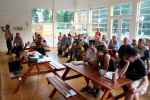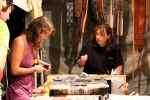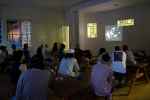Riding to work this morning I descended into one of my typical commuting ruts. Turning right from our road onto Watauga St. most mornings I am struck by the silent beauty of the edge of the Appalachians, as Buffalo Mountain looms over our town, dominating the horizon as I start to descend Watauga towards school and work. It might have been the chill this morning, an unusual October dip into the ’30s Fahrenheit, but I wasn’t moved by the mist-shrouded mountain. I was thinking of this commute. Sometimes I enjoy sunshine and butterflies en route; other times I barely escape with my life. I was thinking on the darker side of things this morning.
You see, I ride my bike to work. Every day. Rain, sun, butterflies, and all. Last winter I noted with grim satisfaction one morning that it was all of 2 degrees (F) as I left the house. It’s not all a self-righteous exercise. I love getting on my bike anytime, and it helps buoy me most days as I head to work, as I blow off steam on the way home. (The thing is, I also love my work, but it is–after all–work.) The bike makes mid-day errands a cinch, and reduces my stress when it comes to parking.
On the other hand, though, I DO sometimes brush with the darker side of life on American roads – the fact that they are the site for an unconscionable number of deaths. Driving through Charleston, SC recently I was reminded of this fact by a flower-wreathed cruiser cycle at a street corner, a memorial to a cyclist killed in traffic.
Motorists have on several occasions failed to pause at a particular stop sign on my morning commute route; I count myself fortunate that each time I or they could able to brake in time to prevent an accident. As with a recent encounter on campus at my school, I sometimes try and express what feel like justified reactions: Why were you talking on your cell phone? Is that conversation worth more than another person’s life? What if it was your son/daughter/father/priest riding this bicycle – would that make you feel worse / prod you to be more careful in how you approach driving?
Or course I’ve yet to have the chance to talk with the people who have almost killed me on the road. Most people seem to think that a wave and smile is enough to smooth over things as I sit there, life flashing in front of me. (I do sometimes have that cliched flash of intense and kaleidoscopic memory in these near-death experiences, it’s an odd thing.) I tried to engage the lady who almost ran me over at school; I refused to give way, holding her up as she sought a rare parking place in the center of campus. she shouted out her sedan window, “I’m sorry!” When I asked her to “Please pay attention when you drive,” though, the woman didn’t seem to realize that I was addressing a systemic disrespect that underlies driving habits. “I said, ‘I’m sorry!'” – a response that seems out of proportion in light of the mortal consequences of her misstep on the gas.
I can sympathize with inattention or ineptitude; I am far from a perfect driver myself. There can be something more insidious at play. A few times it has seemed that some sort of road rage prompts my near-death experiences. A roaring engine, a flash of brightly-colored steel, and a huge Tennessee truck will turn right across my path, as my brakes screech. Do drivers who make this kind of gesture begrudge me the narrow, glass-strewn strip of pavement that I claim as I pedal through town? Do they think that _I_ am breaking the law to travel on the road? To the guy who told me to “Get on the sidewalk” the other day – it is in fact illegal for me to ride on the sidewalk.
That guy isn’t going to stop for a lecture, but I remain open to the possibilities for education that these brushes with death afford me. For instance, I think drivers might be gradually catching on to the standard arm signals I use to indicate that I am turning. Perhaps they don’t remember learning them, as I did, in Drivers’ Ed. On the whole, though, it just pisses me off.
Is that extra 10 seconds worth another person’s life? Is that cellphone conversation or text worth the maiming of a fellow human? This morning the words of an Albert Brumley hymn drifted into my head as I sat at the traffic light at the bottom of Watauga St. – “This world is not my home.” As I continued into the Tree Streets, I sang to myself the verses I remembered, connecting them to my bitter recollection of drivers’ impatience and carelessness: “I can’t feel at home in this world any more.” I thought, “If the world is such a place that something as mundane as driving around can result in arbitrary death, and people aren’t concerned about it enough to change, I don’t want to be part of it!”
This version of the song fits with the music that went through my head along with my rash and self-righteous rants:
After a meeting concluded, I took a second to find the original Brumley verses and sing through it, trying to remember where I had heard the song. No success on remembering a source for my memories, but I liked the song.
Looking through internet traces of the song, I sorted through my theological and emotional responses to the mix of things swirling still in my mind: biking, dying, singing. Looking for lyrics, I found that some versions use the trope of self-reliance to say that “I fixed it up with Jesus”; my brushes with reformed theology make me prefer versions that hew to Brumley’s original text, ascribing agency to the Divine: “My Savior pardoned me.” (See http://hymnal.calvarybaptistsv.org/485.html)
I also found a number of other songs that use the idea of estrangement from the world, often pairing the song with verses like Hebrews 11:13 (“ These all died in faith, not having received the promises, but having seen them afar off, and were persuaded of them, and embraced them, and confessed that they were strangers and pilgrims on the earth.” – KJV) The countering view is that the Earth is an important and somehow durable part of the post-second-coming Kingdom of God. (Writers like Mr. Pope cite Romans 8: http://ethos-environment.blogspot.com/2012/07/this-world-is-not-my-home.html) One version (from Alfred Graley) is set to the tune of “Oh Christmas Tree”:
This one from the 1854 Southern Harmony is more plaintive in describing the earth as a wilderness of woe:

Some versions alienated me; this rendition by the Whites [https://www.youtube.com/watch?v=bvRQLF1VQX8] serves as a musical exemplification of the sort of dispensationalist division between physical and spiritual reality perpetuated by some Christians–makes me grit my teeth. Almost as much as errant drivers.
Even as I am irritated by the brokenness of the world we live in, I do find hope. I make hope, kindle it. With Brumley text in hand, I sought solace in playing and singing the song with a student at the campus Farmers’ Market. The sun broke through and started heating up our chilled fingers, and I was reminded that there is an ultimate reality beyond distracted driving, one where singing and community are the basis for life. THAT world is my home, one that I long for, desperately. I can try to sing myself into that world, as I did today; sometimes I hear a hint of harmony that lets me know I might be near the right path.












